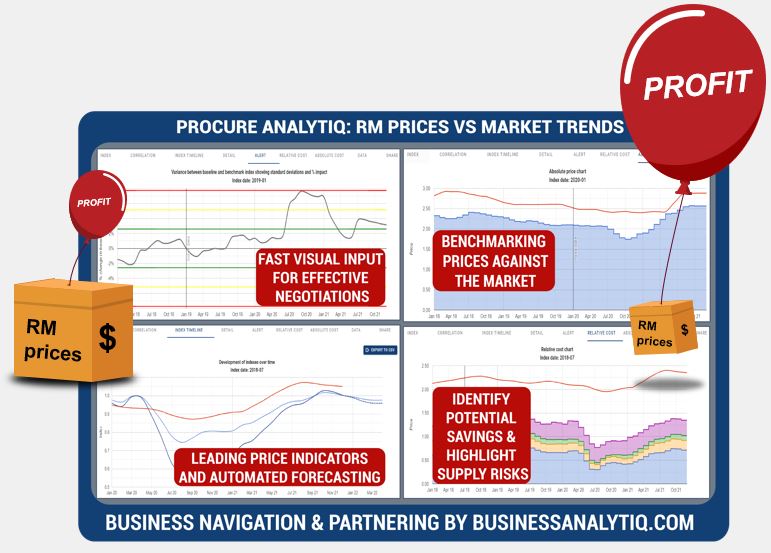Rosin price April 2024 and outlook (see chart below)
- Northeast Asia:US$2.93/KG, unchanged
Business Analytiq assumes no responsibility or liability for any errors or omissions in the content of this site. The information contained in this site is provided on an “as is” basis with no guarantees of completeness, accuracy, usefulness or timeliness.
Rosin (Abietic acid) price index
This post is a summary of the Rosin price developments. The price developments of Rosin are expressed in US$ prices converted FX rates applicable at the time when the price was valid. Rosin price index developments are calculated from multiple separate sources of data to ensure statistical accuracy.
The outlook for Rosin prices, on the second tab, is generated from different inputs including:
- Very recent price developments of immediate cost drivers of Rosin prices
- Recent price developments of underlying feedstocks which drive the price of Rosin
- Market futures for both cost drives and feedstocks of Rosin prices
- Adjustment of current supply/demand imbalances in the Rosin market
- Longer term trends in likely demand conditions
Further information on the Rosin price index
What is Rosin
Rosin is a solid form of resin that is obtained by heating raw resin, which is typically extracted from pine trees. It is used in a variety of applications, including as a wood finish, a soldering flux, and a bow rosin for stringed instruments such as violins and cellos. Rosin is also used in the production of soap, paper, rubber, and printing inks. It has a distinctive, slightly piney aroma and is generally yellow or amber in color. Some people also use rosin as a natural alternative to traditional grip aids for activities such as weightlifting or rock climbing.
Abietic acid is a type of resin acid that is found in many types of resin, including rosin. Rosin is a complex mixture of various types of resin acids, including abietic acid, and is obtained by heating raw resin to release the volatile components and produce a more solid, stable product. Abietic acid is a colorless or pale yellow solid with a characteristic, slightly pungent aroma. It is used in the production of a variety of industrial and consumer products, including lubricants, paints, and paper.
How is Rosin produced
Rosin is produced by heating raw resin, which is typically extracted from pine trees. The resin is collected from the trees in the form of a sticky, yellowish substance called “gum,” which is then purified and refined to produce a more stable and consistent product.
To produce rosin, the raw resin is heated to a high temperature, typically around 250-350°C (480-660°F). As the resin is heated, the volatile components are released, leaving a more solid and stable product. The temperature and duration of heating can be adjusted to produce different grades and types of rosin, depending on the intended application.
After heating, the rosin is cooled and solidified, and then it is usually ground into a fine powder or pressed into blocks or cakes for easier handling and storage. Rosin can also be dissolved in solvents such as turpentine to produce a liquid form of rosin called “rosin oil.”
What is Rosin used for
Rosin is used in a variety of applications, including:
Wood finishing
Rosin is used as a wood finish and can be mixed with other ingredients such as beeswax or oil to create a wood finish that is hard, durable, and water-resistant.
Soldering flux
Rosin is used as a soldering flux to help clean and protect the surfaces being soldered and to improve the flow of the solder.
Bow rosin
Rosin is used as a grip aid on the bow of stringed instruments such as violins and cellos to help the bow grip the strings and produce a clear, smooth sound.
Soap production
Rosin is used in the production of soap as a hardening agent and to give the soap its characteristic lather.
Paper production
Rosin is used in the production of paper as a sizing agent to make the paper more resistant to moisture and to improve its printing quality.
Rubber production
Rosin is used in the production of rubber as a tackifier to improve the adhesive properties of the rubber.
Printing inks
Rosin is used in the production of printing inks as a binder to hold the pigment particles together and to improve the ink’s adhesion to the printing surface.
Grip aid
Some people also use rosin as a natural alternative to traditional grip aids for activities such as weightlifting or rock climbing.
How big is the Rosin market
It is difficult to accurately estimate the size of the global rosin market due to the diverse range of applications for rosin and the lack of comprehensive data on production and consumption. However, rosin is a widely used and important raw material in a variety of industries, including wood finishing, soap production, paper production, rubber production, and printing inks. It is also used as a soldering flux and as a bow rosin for stringed instruments.
According to some estimates, the global market for rosin and resin acids, which includes rosin, was valued at around $3.5 billion in 2020 and is expected to reach $4.5 billion by 2025, growing at a compound annual growth rate of 4.7%. The demand for rosin and resin acids is driven by factors such as increasing construction and infrastructure development, growth in the paper and pulp industry, and the increasing demand for natural and eco-friendly products.
According to https://oec.world/ :
Rosin are the world’s 846th most traded product.
In 2020, the top exporters of Rosin were China ($189M), Brazil ($111M), Portugal ($109M), United States ($104M), and Indonesia ($86.5M).
In 2020, the top importers of Rosin were China ($139M), Germany ($113M), Japan ($72.2M), India ($72M), and Netherlands ($56.7M).
Further information
Business Analytiq
BE THE FIRST TO SEE RISK AND OPPORTUNITY!
BusinessAnalytiq provides unlimited market trend data and an online tools to track market developments, key benchmarks & leading indicators.
BusinessAnalytiq leads to price visibility, better negotiations, easier budgeting and forecasting, lower raw material prices, and improved better internal and external communication. BusinessAnalytiq will decrease risk and higher profit.

Where does the data come from?
- The source of the data are exclusively public non-confidential sources. We have no access to primary data
- This the index trend of the price trend of the "product category" in general, and not a single specification of the product in particular
- The data is a combination of contract and spot pricing
- Our algorithms are set up to eliminate significant product mix impact on the reported price
- We combine public publications, import/export records, trading prices, company announcements, magazine articles, tweets, and other sources of ad-hoc public information.
- The chart shows the our best approximation of the market trend based on our algorithm interpretation of the signals
- For most indexes we have multiple sources and we focus on using statistically-correlated sources
- As a function of our automation, it is likely that recent trends will be adjusted as we discover more information. So, for example, the price trend for February 2024 will be first calculated in February 2024 and adjusted in March, April and May 2024.
- We will update the data trend as more information becomes available, and this means that recent trends will always be adjusted as we get more data available
- The algorithm will regularly revise our understanding of market trends, and indicated market trends may change
- The data is presented in US$. The UOM of measure is shown in the Index list table
- Our automated software and we do our best to create an accurate representation of the trend
Where does the data NOT come from?
- We do not purchase data from any other source and republish it.
- We will not purchase data from any other source and republish it
- We do not extrapolate trends, even for the forecast. We look for other market signals and leading indicators
What data should our company use?
- If you are making decisions driving significant share of profit, we always recommend that you buy data from the companies who invest in direct primary market access such as ICIS, amongst many others
- Our data, at best, represents an estimate of the market trend based on public information
- We have no direct access to the market, and we do not interview suppliers and customers
- Our automated analysis tools in the online software are set up to combine our data with other sources of data
- We do not recommend that you use our data for direct price mechanisms, as we may change and improve the data trends over time, including historical data
What does the quality indication in the main menu mean?
- Quality level A: Data is from a reliable and confirmed source
- Quality level B: Data is from multiple credible sources and there are no major statistical inconsistencies between them
- Quality level C: Data is from multiple credible sources and there are some statistical inconsistencies between them
- Quality level D: Data is from a single credible source, but we cannot verify the data
- Quality level E: Data is either:
- From a single source, which we consider reliable, but we cannot verify the data.
- From 2 or more sources which have some periods of contradicting trends.
- Quality level F: Data is from a single source which we consider indicatively correct, but the data is anecdotal and we cannot verify the data.
What are the disclaimers?
- We assume no responsibility or liability for any errors or omissions in the content of this site.
- The information is provided on an “as is” basis with no guarantee of completeness, accuracy, usefulness, fitness for purpose or timeliness.
- By their nature, outlooks are always uncertain
How often do we update the data?
- We aim to update the data series on the 9th and 24th of each month (but we do not always make it for each chart)
- The data for the current month and recent history are fine-tuned over time.
What are we doing to improve the data?
- We are continually improving our data collection and processing methods
- Pricing data will be updated from time to time as we improve the accuracy
- We are reviewing all data sources in the first half of 2024.
- There will be continuous fine-tuning of the trend and forecast algorithm as part of that.
- The key focus in 2024 is to add many additional indexes
How can i give feedback on the data or request for new indexes
- Feel free to contact us if you have a specific request. You can reach us via the Contact us page

